how to draw contrast in art
The shortest definition of contrast in art that I found was by Shelley Esaak saying that "It is a strategy used by an artist to break up a work of art, and alter or even shatter its unity by inserting variation. In many ways, contrast is the opposite of the element of unity, in that it commands the viewer's attention by sheer force of its differences."
In laic terms, the contrast in art is basically putting two opposing elements together. It's one of the basic art principles used by designers and artists all over the world. For example, you can achieve contrast by combining black and white colors when painting. This is one of the most obvious examples of contrast in art. That's why we love black and white photos, right?
First, I'll explain why contrast in art is important, then I'll share all the different types of contrasts you can achieve, and finally, you'll have a few prompts for creating contrast on your pages.
Why is contrast important in art?
Using contrast in art creates more drama and excitement. If you use contrast on your art journal pages, they'll be bolder, more vivid, and definitely more dramatic. This principle of art can help you achieve more interest and make your pages pop.
With contrast, you can intensify the mood, the colors, and the overall impression of your art. It also enables you to draw attention to the focus of your art journal page.
If you look at the world around you, you'll notice that everything lives in duality. There's life and death, light and dark, big and small, happy and sad, square and round, hard and soft, and so on. We wouldn't know about the light if there was no dark, right?
The same goes for making art. If you intentionally include contrast in your art, you'll see how your art becomes different. It's so fun to experiment and then explore all the results and effects you get with this.
To convince you even more, let me quote Scott Trettenero from Psychreg: "Duality teaches us that every aspect of life is created from a balanced interaction of opposite and competing forces. Yet these forces are not just opposites; they are complementary. They do not cancel out each other, they merely balance each other like the dual wings of a bird."
The thing is, we want to unify our pages by using contrast, not to cancel each other out. We want to create balance and convey the message of unity, and finally, celebrate the duality and all the possibilities we have while creating art.
DOWNLOAD THE FREE BEGINNER'S ART JOURNAL STARTER KIT
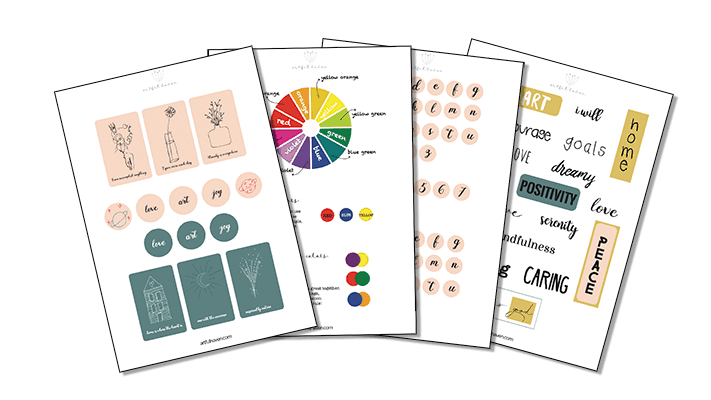
What are the different types of contrast in art?
Now that you've learned the importance of contrast in art, let's dig in all the different ways you can achieve this on your art journal pages.
1. Color contrast
If you look at the color wheel, you'll see that complementary colors are contrast colors as well (they contrast each other on the wheel). So, red and green are contrast colors, as well as blue and orange.
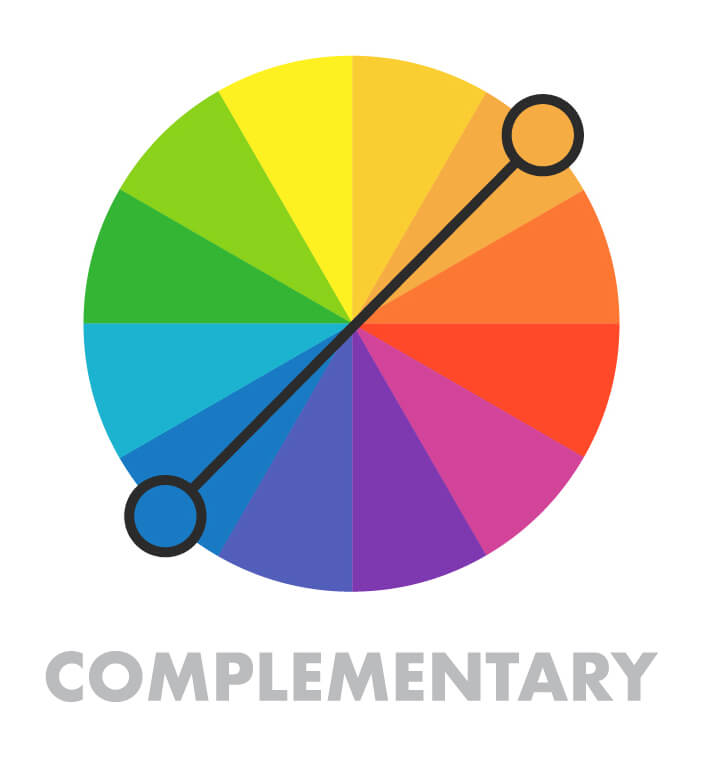
Color contrast is also called hue contrast and it includes different contrasts between the colors on the color wheel. However, color contrast has more to it. These complementary colors above can sometimes be hard on our eyes. For example, if you read a red text on a green surface, the text would become a bit blurry.
Hue contrast example with blue and orange:
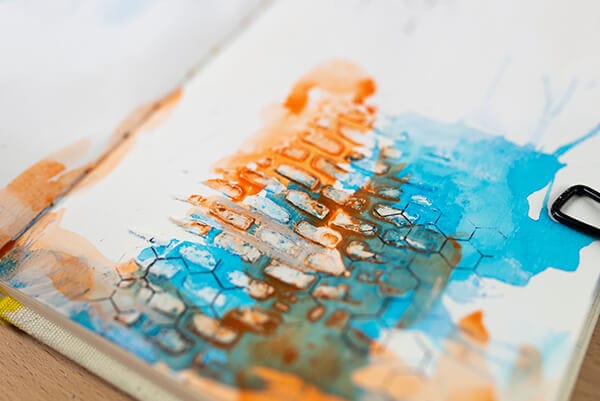
However, color contrast can be further separated into value contrast and saturation contrast. The value of a certain color is its lighter or darker variations. So, if you take a darker red and lighter green, that blurry effect (I mentioned above) will disappear and will be easier to look at.
Value contrast is the difference between lighter and darker colors in an image, which is best seen in the contrast between black and white, which are the two extremes. In the example below, you can see the contrast between the black and white shapes, plus the text in contrast, too.
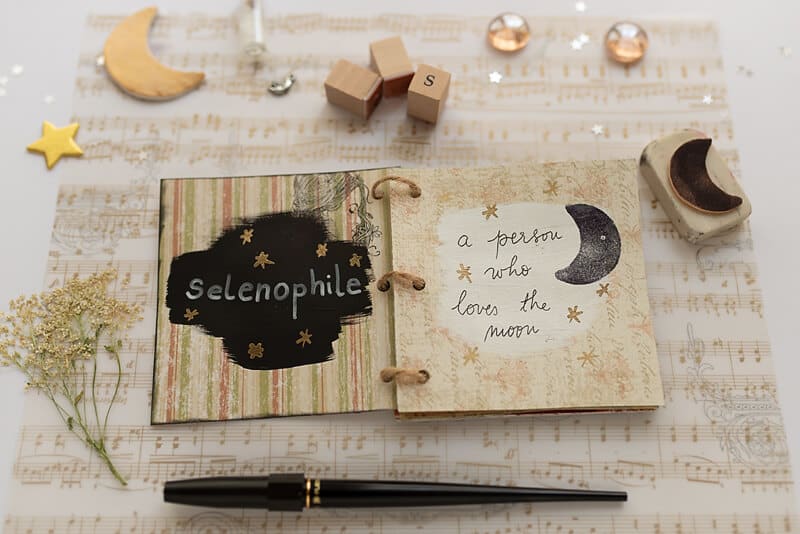
It is the contrast of thinly applied darks sitting next to impasto lights that gives the effect of transparency and bouncing light.
Gail Boyle
There's also saturation contrast which refers to the difference between bold, saturated colors and dull colors. For example a saturated blue against a dull orange and yellow. Or, as in the example below: saturated green against a dull blue.
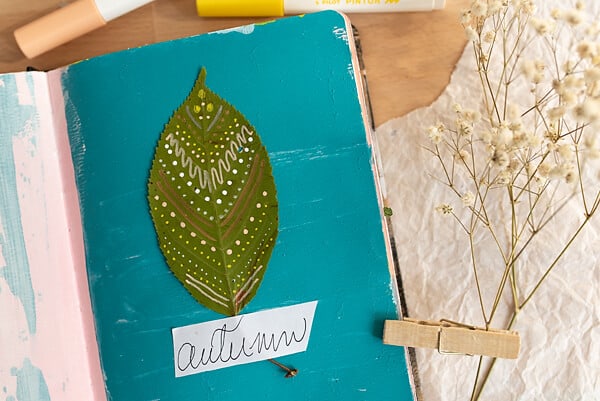
2. Texture contrast
To achieve texture contrast you can play with smooth and rough surfaces. For example, f you want to emphasize softness, add a bit of roughness to it. Playing with texture can also create motion and drama. Imagine painting a sea with textured and soft amounts of paint. The sea would look very much alive, wouldn't it?
I played with texture in the example below. My background has a bit of texture but my foreground is all even more textured with paint, paper scraps, and a napkin.
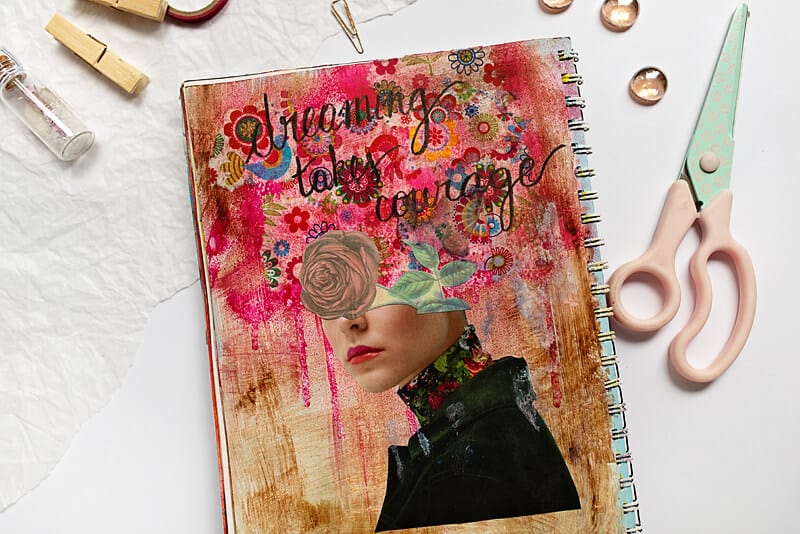
For more depth on your pages, use this contrast by putting the rough places as the foreground and smoother surface as the background. This way, a textured foreground pops out of the image and that's how you accentuate it.
3. Shape contrast
Playing with shapes is also fun and you can experiment endlessly. Contrasting shapes means using geometrical vs. organic shapes, or big vs. small shapes, or even circles vs. squares. Imagine how many possibilities you have here.
I'd also like you to remember that this type of contrast in art doesn't have to be only drawing and painting shapes as they are. For example, you can paint a group of objects that form a small circle vs. another group or one object that form a bigger square. You can mix and match the differences and relations and really enjoy this artistic experimentation.
This is an example of a literal shape contrast by using circles vs. squares and rectangles:

Or in this example, where the three small circles contrast the 3 rectangles: the red background, the book page and the washi tape.

4. Line contrast
You can also create contrast with different lines, especially if you make patterns with them. Try mixing long lines with short lines, straight lines with curvy or wavy ones, continuous lines with dotted lines, etc.
An interesting page would be with the combination of thick and thin lines as the background and don't be surprised if this creates an illusion on your page.
However, you don't have to draw lines to achieve this effect. Just by creating elements with straight lines vs. curvy lines can result in the effect of line contrast. In the image below you can see the brown elements being curved vs. straight lines of papers and washi tape.
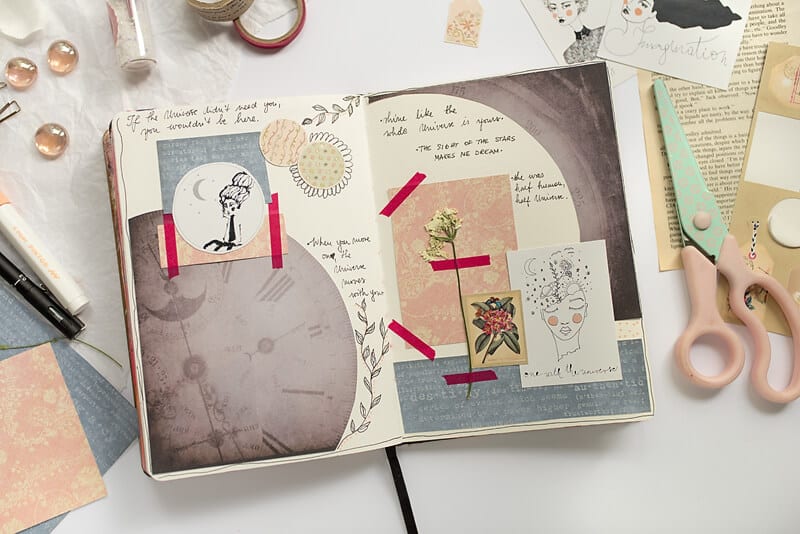
5. Size contrast
We create this type of contrast all the time, but we're mostly not aware of it at the moment. But the contrast between big and small elements can be even stronger if you do it with intention.
In the photo below, there's a strong contrast between the trees and the human figure. This is a great way to emphasize an element on your page: by contrasting it to a smaller elements. This human figure becomes an important part of the message of this page, and that's why it's emphasized. To be honest, this wasn't my strategy from the beginning, I was just creating.
But later, I realized I created contrast, emphasized the shape, which was supposed to stand out in some way.
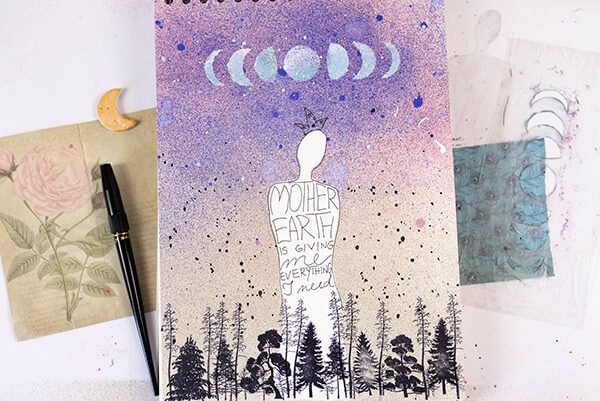
6. Edge contrast
This means that your elements can have a soft or hard edges. I think about watercolor immediately. When you paint with watercolor, you can create shapes with amazingly soft edges, but you can also make them hard and visible.
The two examples below show how painting with watercolor, you can achieve a hard edge that looks bold and clearly visible. In the other photo, the hair is painted very softly and thus I created lightness and airiness.
-
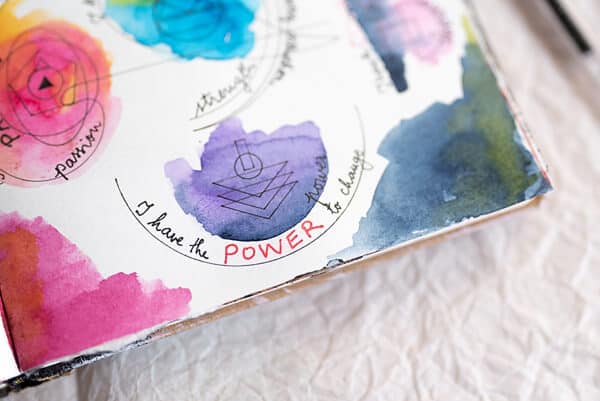
mostly hard edges -

mostly soft edges
If you combine hard and soft edges, you can create beautiful contrast and make things pop out on your page. For example, if you make a watercolor background with soft edges, try contrasting it against the main element with hard edges.
Here's how to accomplish soft and hard edges in watercolor.
When you want to paint hard edges, make sure your brush is rich with paint, and less with water. Also, don't move the paint much, but rather abruptly stop with your brush so the paint can leave a hard and bold mark.
On the contrary, for soft edges, use more water than the pigment and softly blend it with your brush until you can barely see the edge, until it's almost transparent.
7. Temperature contrast
In the canvas of life, a flat landscape would be pretty boring. It is the valleys and the mountains that help us to appreciate the flatlands. It is the dark that makes us appreciate the light, and the cold that makes us appreciate the warm.
Anne Copeland
To achieve temperature contrast in art, you should know the difference between warm and cool colors. Imagine warm color as produced by the sun, and cool ones connected to cold and winter.

I love creating contrast with temperature. In the example below, I combined the yellow shirt on the girl with the cool (pink, blue, purple) background and paper scraps.
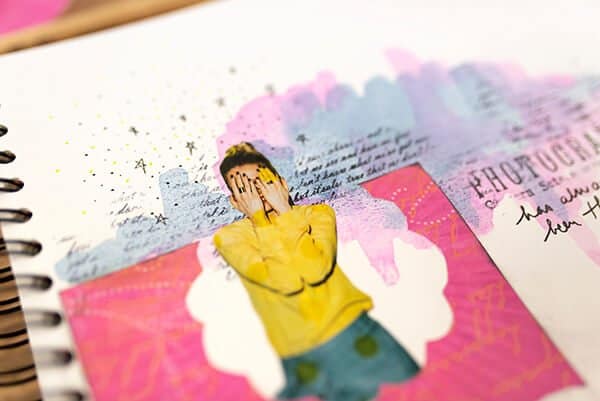
8. Space contrast
When you open your art journal and look at all that white space, you freeze. Most of us feel helpless when staring at the blank page.
As Paul Wallas, in his article about design practice, says: "…the temptation to fill empty space is an easier process than the discomforting feeling we experience when we see large areas of white (negative) space left unoccupied."
However, what if you change your perspective from the beginning and use this space as positive, already filled white area for your page? What if you use it to create contrast and really shift focus to something meaningful on your page?
For example, if you paint a small circle somewhere in this white space, you create a strong contrast already. Paul Wallas also says that "when working with space, the best recommendation is to not think of space as a negative but to think of it as a positive — 'active' space."
This active space is great grounds for you to add elements in contrast to it. In other words, use the white space as the background for your most important element. This doesn't have to be literal like adding a dot and calling it a day. But if you leave enough of this white space, it will contrast with your other elements and shift the focus to them, rather than inviting your eyes all over the place until your head hurts.
Here are some examples where I used the white space to emphasize the focus of the page.
-
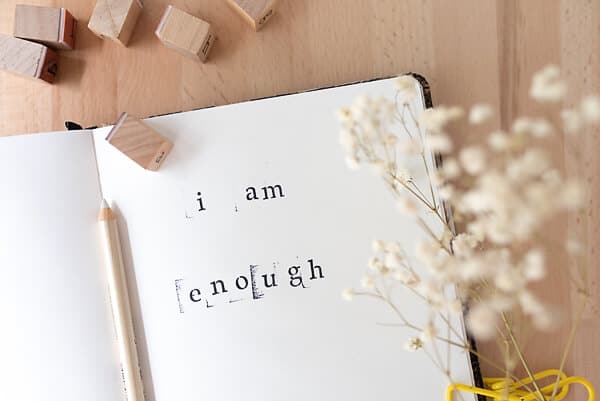
I used only letters on a white page -
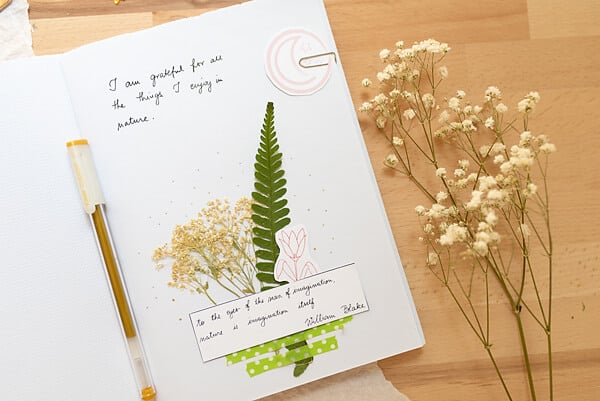
I gathered most of the elements in one place, leaving a lot of white space around it
Another thing I'd like to add is that the "white space" doesn't have to be white at all. Maybe we could call it empty space, not filled with any elements. But, it can be in another color than the white. Any monotonous surface where you can contrast single elements to it can serve as this "white, empty space".
For example, in the photo below, the background is only black, it's monotonous and you could call it empty space. But when you add an element that contrasts it, it breaks the empty space a bit, and you get a strong contrast.
That contrast is even stronger here because of the combination of black and white colors. If I added more elements, the focus on the human shape would be weaker because our eyes would be busier going all over the page.

Contrast in art is fun, but don't overdo it
Creating contrast is fun and there are no limits to the experimentation and learning. It's a great feeling when you discover something that works for you and helps you get your art on another level.
However, as in everything in life, be careful not to overdo it. First of all, you might get bored with it quickly. And second of all, you might loose the contrast if you overdo the elements and stuff your page to look like a bunch of disconnected elements.
Always make it as simple as possible, especially if you're just beginning to explore this. With time, you'll be confident enough to use contrast in art in many different ways.
Art journal prompts and ideas for creating contrast
Prompt 1.
Experiment with black and white paint and shapes. Use white elements on a black background or vice versa.
Prompt 2.
Use the negative white space and add elements only in one area to contrast the white space. For example, watercolor paint and an image.
Prompt 3.
Create value contrast by using only one color in its dark and light values. For example, if you use blue watercolor, lighten it by adding more water, and darken it by adding more paint, or even black to it. If you use acrylic paint, lighten it by adding white to it. Your painting will be monochrome, only blue, but with different values. And make that distinction really pop. Boldly explore the value contrast.
Prompt 4.
Create temperature contrast by using one cool and one warm color. You can use one for the background and the other for elements on your page. Also, if you're up to it, try using different values (lights and darks) of those two colors.
For example, you can paint flowers with warm color against a cool background or vise versa.
And to inspire you even more, here's a beautiful quote about contrast in life:
Without contraries is no progression. Attraction and repulsion, reason and energy, love and hate, are necessary to human existence.
William Blake
DOWNLOAD THE FREE ART JOURNAL STARTER KIT
You'll get instant access to my free resource library packed with art journal printables and cheat sheets for color theory and composition.

how to draw contrast in art
Source: https://artfulhaven.com/contrast-in-art/
Posted by: williamsalksomed.blogspot.com

0 Response to "how to draw contrast in art"
Post a Comment